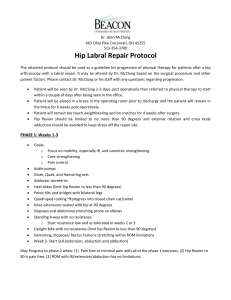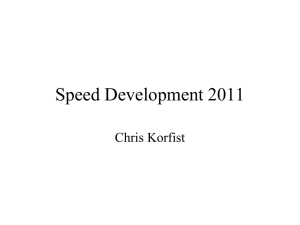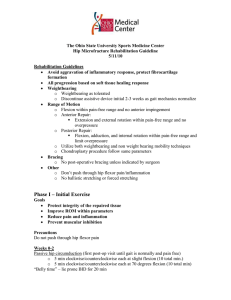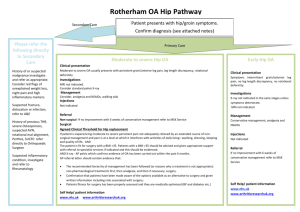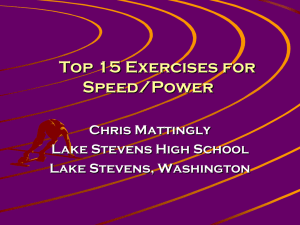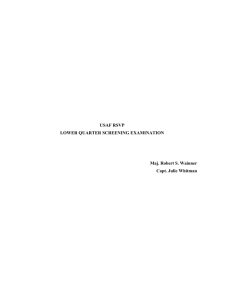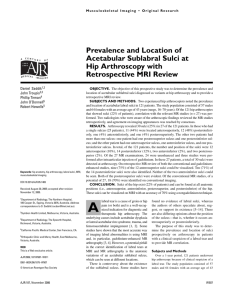Delaware Physical Therapy Clinic: Hip Arthroscopy Protocol.
advertisement
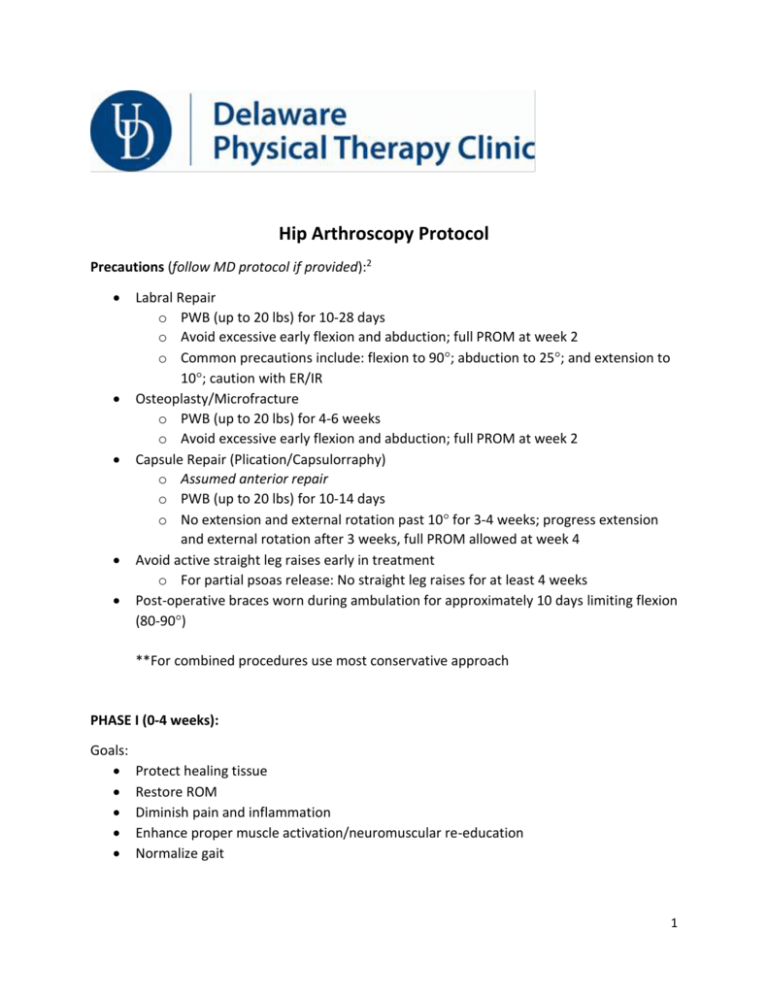
Hip Arthroscopy Protocol Precautions (follow MD protocol if provided):2 Labral Repair o PWB (up to 20 lbs) for 10-28 days o Avoid excessive early flexion and abduction; full PROM at week 2 o Common precautions include: flexion to 90; abduction to 25; and extension to 10; caution with ER/IR Osteoplasty/Microfracture o PWB (up to 20 lbs) for 4-6 weeks o Avoid excessive early flexion and abduction; full PROM at week 2 Capsule Repair (Plication/Capsulorraphy) o Assumed anterior repair o PWB (up to 20 lbs) for 10-14 days o No extension and external rotation past 10 for 3-4 weeks; progress extension and external rotation after 3 weeks, full PROM allowed at week 4 Avoid active straight leg raises early in treatment o For partial psoas release: No straight leg raises for at least 4 weeks Post-operative braces worn during ambulation for approximately 10 days limiting flexion (80-90) **For combined procedures use most conservative approach PHASE I (0-4 weeks): Goals: Protect healing tissue Restore ROM Diminish pain and inflammation Enhance proper muscle activation/neuromuscular re-education Normalize gait 1 Interventions: Manual Therapy: o Soft tissue techniques to iliopsoas, ITB/TFL, adductors, gluteus medius o Gentle joint mobilizations o Scar massage Mobility: o PROM within restrictions/pain-free range o Do not move through soft tissue restriction until 2.5 weeks post-op o Examples: Stationary bike: no resistance until week 6 Aquatic therapy starting 7-10 days post-op Hip circumduction @ 30 of flexion and 70 of flexion FABER Slides w/ PT assist: begin at 4 weeks Cat/Camel in Quadruped Hook-lying Butterflies and Reverse Butterflies Quadruped Posterior Rocks (for hip flexion) SKTC (iliopsoas stretch); full range on uninvolved side Stool Rotations (IR/ER) Strength: Quad sets Gluteal sets: supine, prone, tall kneeling, ½ kneeling Isometrics: abd/add (supine); IR/ER (prone); no flexion Prone TKE->standing TKE, SAQ, hamstring curls; heel slides Prop up position (belly time) for at least 20 minutes/day TA activation; TA marching; posterior pelvic tilt Bridges (within pain-free ROM) Weight-Shifts @ 2 weeks post-op Clamshells @ 3 weeks post-op if pain-free; progress to reverse clamshells Forward Step up Isotonic hip abduction/adduction/extension (end of phase 1/beginning of phase 2) Balance: SLS Criteria to progress to Phase II: ROM greater than or equal to 75% of uninvolved side Performance of phase II interventions with minimal pain Full weight bearing 2 PHASE II (4-8 weeks): Goals: Progress ROM Transition focus to strengthening No ballistic movements or forceful stretching Interventions: Manual therapy: o Progress joint mobilizations (avoid aggressive traction) Mobility: Stationary bike: with resistance at week 6; consider elliptical Thomas test stretch, ½ kneeling hip flexor stretch (progress @ week 6 by turning upper body away from surgical leg), standing ITB stretch, standing hamstring stretch Independent FABER slides Strength: o Increased focus on gluteal and core strengthening Bridge progression Legs on physioball Marching (@ 6 weeks) Single leg (@ 6 weeks) Steamboats (stance leg=surgical leg) Ball wall squats (progress to posterior squats) Resisted seated internal and external rotation; Resisted Stool IR/ER with TB Leg press/unilateral leg press Start at 45 and progress as tolerated Step and holds Romanian deadlifts Side steps and posterior reaches with TB Split squats/lunges Kneeling front planks @ week 6; Full planks @ week 8 Side planks; progress to S/L plank with hip ABD SLS with TB cross-body pull Balance: SLS on unstable surfaces (Foam/BOSU) 3 Criteria to progress to Phase III: Full ROM Normal and pain-free gait pattern (without trendelenberg) Hip flexion strength greater than 60% of uninvolved side All other strength measurements (ab/add/ext/IR/ER) greater than 70% of uninvolved side PHASE III (8-12 weeks): Goals: Restore endurance/strength/balance Incorporate multi-planar movements Progress hip strengthening in functional positions Interventions: Manual Therapy: o Continue joint mobilizations as needed (may add long axis distraction and AP mobilizations) Mobility: o Continue phase I and II stretches as needed Strength: Standing resisted hip external rotation Three position squats Band hip flexor protocol Walking lunges Reverse lunge with X chop Side steps with X chop SL squats with chair taps Sport cord walking Plyometrics @ 10-12 weeks Shuttle DL and SL hops DL mini hips in place Agility drills (single plane) May add crunches and sit ups if no hip pinching Criteria to progress to Phase IV: Hip flexion strength 70% of uninvolved side All other strength measurements greater than 80% of uninvolved side Performance of initial agility drills with proper mechanics 4 PHASE IV Exercises: (12-16 weeks): Goals: Return to full level of function and/or sport Interventions:4 Mobility: Seated FABER stretches Inch worms Hurdle steps Walking spiderman stretch Dynamic strengthening/stability: Hop ups/downs DL and SL line jumps 3-way hop drill 3-way jog matrix Agility ladder drills Initiate walking/jogging program after 12 weeks Criteria to return to sport: No signs of FAI Full and pain free ROM Ability to perform sport-specific drills at full speed without pain Greater than or equal to 90% on HOS or 90% on global rating scale <10% side to side difference with: o Single leg hop/single leg triple hop tests References: 1. ATI: Rehabilitation Guidelines for Hip Labral Injuries 2. Enseki KR, Martin RL, Draovitch P, et al. The Hip Joint: Arthroscopic Procedures and Postoperative Rehabilitation. J Orthop Sports Phys Ther. 2006; 36(7): 516-525. 3. Garrison JC, Osler MT, Singleton SB. Rehabilitation after arthroscopy of an acetabular labral tear. North American Journal of Sports Physical Therapy. 2007; 2(4): 241-250. 4. Ohio State Hip Arthroscopy Rehabilitation Protocol 5. Stalzer S, Wahoff M, Scanlan M. Rehabilitation Following Hip Arthroscopy. Clin Sports Med. 2006; 337-357. 6. UPMC Hip Arthroscopy Rehabilitation Protocol 7. Voight ML, Robinson K, Gill L, Griffin K. Postoperative Rehabilitation Guidelines for Hip Arthroscopy in an Active Population. Sports Health. 2010; 2(3): 222-230. 5
